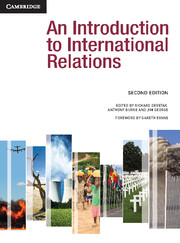Book contents
- Frontmatter
- Contents
- Tables, Figures and Boxes
- Contributors
- Preface and acknowledgements
- An Introduction to International Relations: The origins and changing agendas of a discipline
- 1 Theories of International Relations
- 2 The Traditional Agenda
- 9 The Modern State
- 10 Nations and Nationalism
- 11 Security
- 12 Arms Control
- 13 The Causes of War
- 14 The Changing Character of Warfare
- 15 The Ethics and Laws of War
- 16 International Law
- 17 International Society and European Expansion
- 18 Diplomacy
- 19 Great Powers
- 20 The Cold War
- 3 The New Agenda
- Glossary of Terms
- Bibliography
- Index
- References
12 - Arms Control
from 2 - The Traditional Agenda
- Frontmatter
- Contents
- Tables, Figures and Boxes
- Contributors
- Preface and acknowledgements
- An Introduction to International Relations: The origins and changing agendas of a discipline
- 1 Theories of International Relations
- 2 The Traditional Agenda
- 9 The Modern State
- 10 Nations and Nationalism
- 11 Security
- 12 Arms Control
- 13 The Causes of War
- 14 The Changing Character of Warfare
- 15 The Ethics and Laws of War
- 16 International Law
- 17 International Society and European Expansion
- 18 Diplomacy
- 19 Great Powers
- 20 The Cold War
- 3 The New Agenda
- Glossary of Terms
- Bibliography
- Index
- References
Summary
Introduction
This chapter examines the evolution and practices of arms control in international relations. It begins by discussing what arms control is and why it has featured so prominently in world politics, even after the ending of the Cold War, the period during which arms control can be said to have developed extensively. After a discussion of the various weapons that are covered by arms control processes, and the legal regimes that accompany these, the chapter proceeds to outline some of the ways in which arms control can be conceptualised and how various schools of thought in international relations can be related to arms control practices. We then look at the specific case of the nuclear weapons regime, as more states acquire nuclear weapons, and as calls increase for the elimination of these particular weapons of mass destruction (WMDs). The chapter also examines how a number of key states have been involved in upholding various arms control and disarmament regimes in the contemporary period.
What is arms control?
Arms control can be described simply as any arrangement made directly between adversaries or multilaterally by the broader international community to limit the weapons that might be used in warfare. A more formal, or classical, definition of arms control is provided by Hedley Bull: ‘Arms control is restraint internationally exercised upon armaments policy, whether in respect of the level of armaments, their character, deployment or use’ (Bull 1961: vii). Arms control can be conducted as a formal process involving treaties and other binding arrangements, or as an informal practice between states. These processes or steps can be unilateral, bilateral or multilateral; the most essential element is a willingness to cooperate with other states to achieve security interests. These interests could be ‘exclusively those of the cooperating states themselves’ or interests that are ‘more widely shared’ in the international community (Bull 1961: 2).
- Type
- Chapter
- Information
- An Introduction to International Relations , pp. 172 - 188Publisher: Cambridge University PressPrint publication year: 2011

